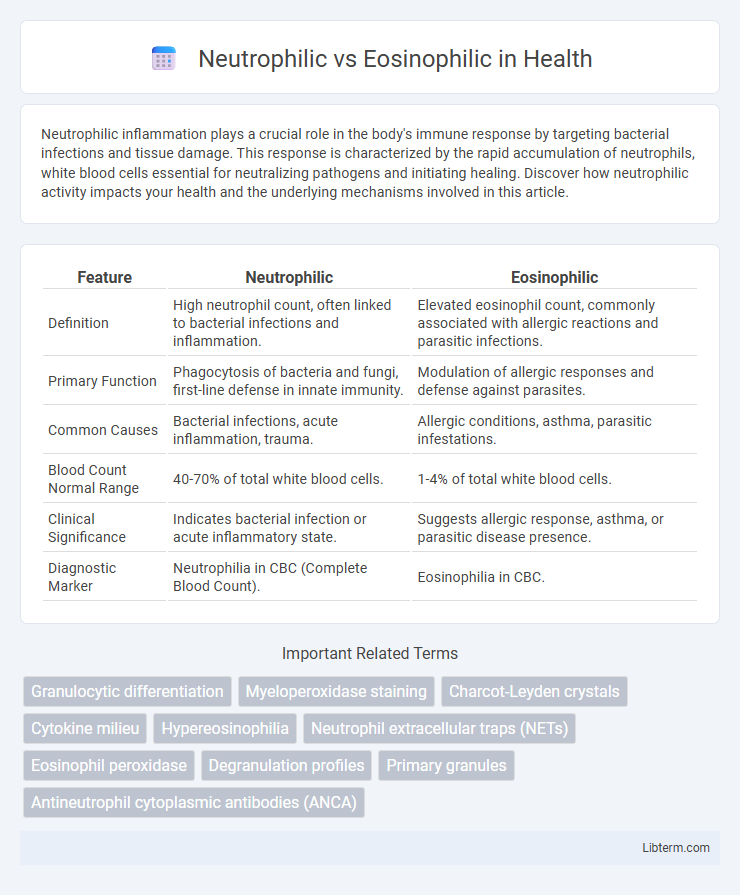Neutrophilic inflammation plays a crucial role in the body's immune response by targeting bacterial infections and tissue damage. This response is characterized by the rapid accumulation of neutrophils, white blood cells essential for neutralizing pathogens and initiating healing. Discover how neutrophilic activity impacts your health and the underlying mechanisms involved in this article.
Table of Comparison
| Feature | Neutrophilic | Eosinophilic |
|---|---|---|
| Definition | High neutrophil count, often linked to bacterial infections and inflammation. | Elevated eosinophil count, commonly associated with allergic reactions and parasitic infections. |
| Primary Function | Phagocytosis of bacteria and fungi, first-line defense in innate immunity. | Modulation of allergic responses and defense against parasites. |
| Common Causes | Bacterial infections, acute inflammation, trauma. | Allergic conditions, asthma, parasitic infestations. |
| Blood Count Normal Range | 40-70% of total white blood cells. | 1-4% of total white blood cells. |
| Clinical Significance | Indicates bacterial infection or acute inflammatory state. | Suggests allergic response, asthma, or parasitic disease presence. |
| Diagnostic Marker | Neutrophilia in CBC (Complete Blood Count). | Eosinophilia in CBC. |
Understanding Neutrophils and Eosinophils
Neutrophils are the most abundant white blood cells, primarily responsible for combating bacterial infections through phagocytosis and releasing enzymes that destroy pathogens. Eosinophils play a key role in combating parasitic infections and modulating allergic inflammatory responses by releasing cytotoxic granules and cytokines. Both neutrophils and eosinophils originate from myeloid progenitors in the bone marrow and are critical components of the innate immune system, each with distinct functions and activation mechanisms.
Key Roles in the Immune System
Neutrophils serve as the first line of defense by rapidly responding to bacterial and fungal infections through phagocytosis and release of antimicrobial enzymes. Eosinophils primarily target parasitic infections and modulate allergic inflammatory responses by releasing cytotoxic granules and cytokines. Both cell types orchestrate distinct yet complementary roles in immune system regulation and pathogen elimination.
Morphological Differences
Neutrophilic cells are characterized by their multilobed nuclei and fine, pale granules in the cytoplasm, whereas eosinophilic cells exhibit bilobed nuclei and large, bright red-orange granules due to eosin dye affinity. The granules in neutrophils are primarily azurophilic and specific, aiding in pathogen destruction, while eosinophilic granules contain major basic protein and enzymes targeting parasites. Morphological differences reflect their distinct roles in immune response, with neutrophils specializing in bacterial defense and eosinophils in combating parasitic infections and modulating allergic reactions.
Causes of Neutrophilia vs Eosinophilia
Neutrophilia is primarily caused by bacterial infections, acute inflammation, stress, trauma, or corticosteroid use, leading to an elevated neutrophil count as part of the body's immune response. Eosinophilia arises due to allergic reactions, parasitic infections, autoimmune diseases, and certain malignancies, characterized by increased eosinophil levels targeting specific immune pathways. Understanding the distinct etiologies of neutrophilia and eosinophilia is crucial for accurate diagnosis and targeted treatment strategies in clinical practice.
Common Diseases Associated with Each
Neutrophilic inflammation is primarily associated with bacterial infections, acute appendicitis, and chronic obstructive pulmonary disease (COPD), characterized by rapid recruitment of neutrophils to infection sites. Eosinophilic inflammation commonly occurs in allergic diseases such as asthma, eosinophilic esophagitis, and certain parasitic infections, driven by elevated eosinophil levels causing tissue damage and hypersensitivity responses. Understanding these cellular patterns aids in diagnosing and targeting treatments for infections and inflammatory disorders.
Diagnostic Techniques and Biomarkers
Neutrophilic inflammation is commonly diagnosed using biomarkers such as elevated neutrophil counts in blood or sputum, alongside imaging and culture techniques to detect bacterial infections. Eosinophilic inflammation is typically identified by measuring eosinophil levels in blood, sputum, or tissue biopsies, with additional reliance on biomarkers like eosinophil cationic protein (ECP) and fractional exhaled nitric oxide (FeNO) for asthma characterization. Advanced diagnostic techniques including flow cytometry and immunohistochemistry enhance differentiation between neutrophilic and eosinophilic patterns, aiding targeted therapy decisions.
Clinical Manifestations and Symptoms
Neutrophilic inflammation typically presents with acute symptoms such as redness, swelling, pain, and fever, often indicating bacterial infections or acute tissue injury. Eosinophilic inflammation is associated with allergic reactions and parasitic infections, manifesting as itching, wheezing, and tissue remodeling in conditions like asthma or eosinophilic esophagitis. Distinguishing between neutrophilic and eosinophilic clinical presentations aids targeted therapy, with neutrophilic responses requiring antibiotics or anti-inflammatory agents, while eosinophilic patterns respond to corticosteroids and anti-allergic treatments.
Treatment Approaches and Strategies
Treatment approaches for neutrophilic inflammation typically involve antibiotics to target bacterial infections and corticosteroids to reduce excessive immune response. Eosinophilic inflammation often requires corticosteroids and targeted biologics like anti-IL-5 or anti-IL-4 receptor antibodies to specifically inhibit eosinophil activity. Understanding the underlying cause guides therapy, where neutrophilic cases benefit from antimicrobial agents while eosinophilic conditions respond better to immunomodulatory and biologic treatments.
Prognostic Implications
Neutrophilic inflammation often indicates acute infection or tissue injury and is associated with poor prognosis in chronic diseases such as COPD and ARDS due to heightened tissue damage and impaired resolution. Eosinophilic inflammation, prevalent in asthma and certain parasitic infections, generally predicts better treatment response and improved outcomes when targeted with corticosteroids or biologics. Distinguishing between neutrophilic and eosinophilic profiles enables precise prognostication and tailored therapeutic strategies to optimize patient survival and quality of life.
Future Research and Therapeutic Insights
Future research on neutrophilic versus eosinophilic inflammation is poised to explore molecular pathways and cellular mechanisms that differentiate their roles in disease pathogenesis, potentially identifying novel biomarkers for precise diagnosis. Advancements in targeted therapies could emerge from understanding how neutrophil extracellular traps (NETs) and eosinophil granule proteins interact with tissue microenvironments, enabling the development of personalized treatments for conditions like asthma and chronic obstructive pulmonary disease (COPD). Integration of genomic and proteomic data will likely refine therapeutic strategies, improving efficacy and reducing adverse effects by selectively modulating these immune responses.
Neutrophilic Infographic

 libterm.com
libterm.com